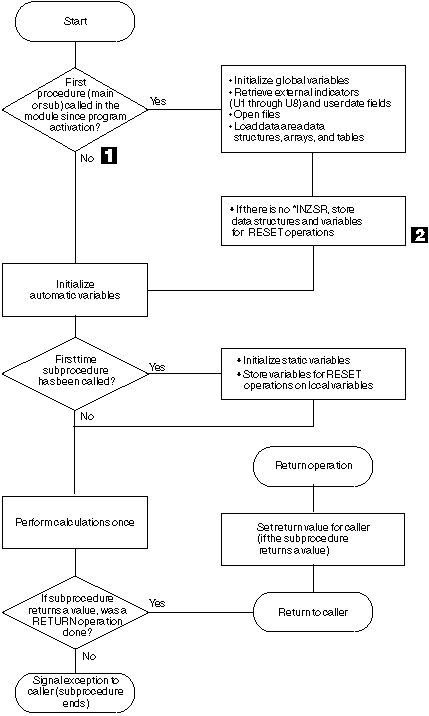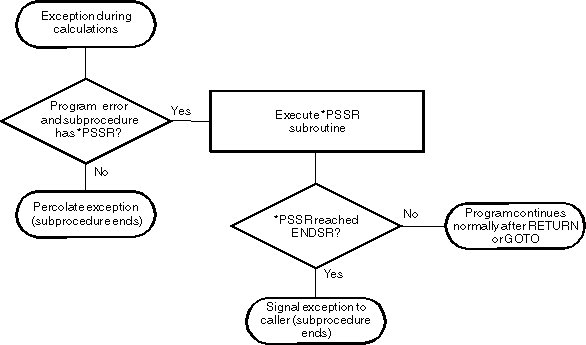Subprocedure Calculations
No cycle code is generated for a subprocedure, and so
you must code it differently than you would code a cycle-main
procedure. The subprocedure ends when one of the following occurs:
- A RETURN operation is processed
- The last calculation in the body of the subprocedure is processed.
Figure 1 shows the normal processing steps for a subprocedure. Figure 2 shows the exception/error handling sequence.

- 1
- Taking the "No" branch means that another procedure has already been called since the program was activated. You should ensure that you do not make any incorrect assumptions about the state of files, data areas, etc., since another procedure may have closed files, or unlocked data areas.
- 2
- If an entry parameter to the main procedure is RESET anywhere in the module, this will cause an exception. If it is possible that a subprocedure will be called before the main procedure, it is not advised to RESET any entry parameters for the cycle-main procedure.

Here are some points to consider when coding subprocedures:
- There is no *INZSR associated with subprocedures. Data
is initialized (with either INZ values or default values) when the
subprocedure is first called, but before the calculations begin.
Note also that if the subprocedure is the first procedure to be called in a module, the *INZSR of the cycle-main procedure (if present) will not be run, although other initialization of global data will be done. The *INZSR of the cycle-main procedure will be run when the cycle-main procedure is called.
- When a subprocedure returns normally, the return value, if specified on the prototype of the called program or procedure, is passed to the caller. Nothing else occurs automatically. All files and data areas must be closed manually. Files must be written out manually. You can set on the LR or RT indicators, but it will have no immediate effect on the program termination. If the the subprocedure was called by a cycle-main procedure, the setting of the LR or RT indicators would take effect when the RPG cycle reached the point at which RPG checks those indicators.
- Exception handling within a subprocedure differs from
a cycle-main procedure primarily because there is no default exception
handler for subprocedures and so situations where the default handler
would be called for a cycle-main procedure correspond to abnormal
end of the subprocedure. For example, Factor 2 of an ENDSR operation
for a *PSSR subroutine within a subprocedure must be blank. A blank
Factor 2 of the ENDSR for the *PSSR subroutine in a cycle-main procedure
would result in control being passed to the default handler. In a
subprocedure, if the ENDSR of the *PSSR subroutine is reached, then
the subprocedure will end abnormally and RNX9001 will be signalled
to the caller of the subprocedure.
You can avoid abnormal termination either by coding a RETURN operation in the *PSSR, or by coding a GOTO and label in the subprocedure to continue processing.
- The *PSSR error subroutine is local to the subprocedure.
- You cannot code an INFSR in a subprocedure, nor can you use a file for which an INFSR is coded.
- Indicators that control the cycle function solely as conditioning indicators when used in a linear module (MAIN or NOMAIN on control specification); or in a subprocedure that is active, but where the cycle-main procedure of the module is not. Indicators that control the cycle include: LR, RT, H1-H9, and control level indicators.